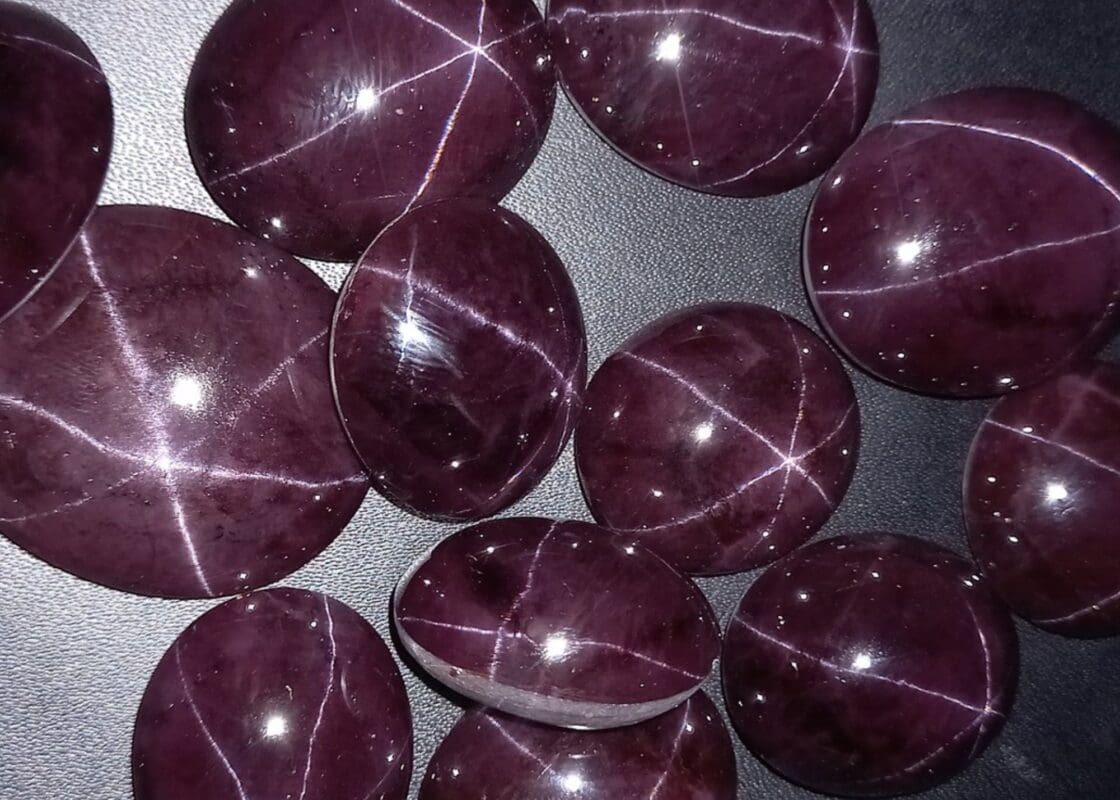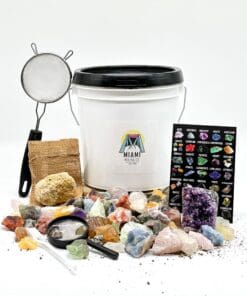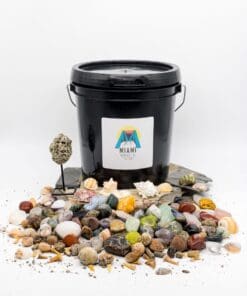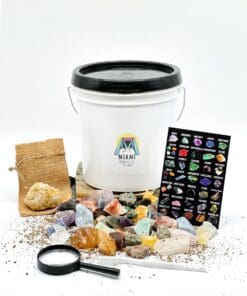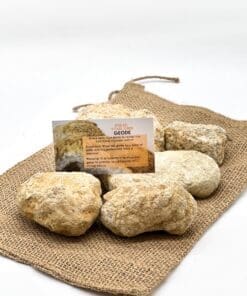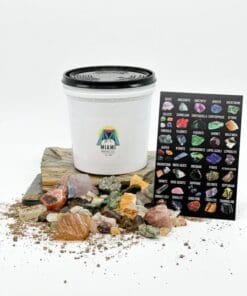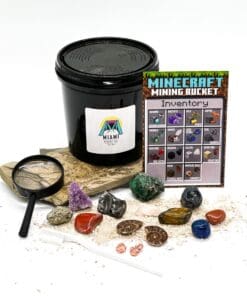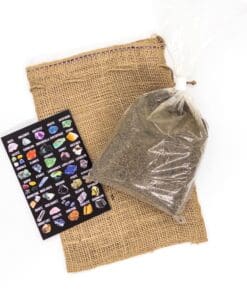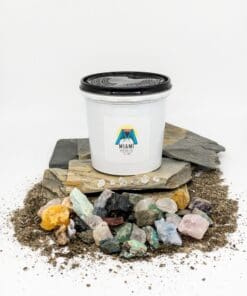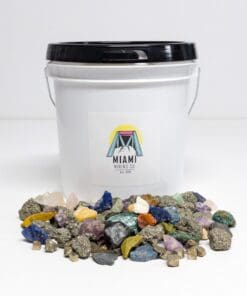Gem Mining Idaho: Unearth Hidden Treasures in the Gem State!
Nicknamed the ‘Gem State’, Idaho boasts a rich tapestry of mineral wealth, promising gem enthusiasts a delightful experience. From garnets to opals, the state’s rugged landscape offers a variety of precious and semi-precious stones. This article aims to guide you through Idaho’s gem mining history, popular sites, regulations, and more.
The Most Popular Gemstones in Idaho
Idaho’s expansive geology and unique positioning make it a treasure trove for gem enthusiasts. While there are a variety of gemstones to be found, some are rarer than others. Below, we provide a detailed breakdown:
Rare Gemstones Found in Idaho
| Gemstone | Description |
|---|---|
| Star Garnet | A unique gem that exhibits a star-like pattern due to its reflective surface; Idaho and India are the only places where they can be found in abundance. |
| Fire Opal | This opal variety showcases vibrant red, orange, and yellow hues, resembling flames. |
| Blue Garnet | A rare garnet variant that shifts color from greenish-blue in daylight to purplish-red under incandescent light. |
| Idaho Garnet | Idaho’s namesake garnet, it is sought after for its deep red, almost maroon hue. |
| Beryl | Typically found in pegmatites and certain metamorphic stones, beryl can range from transparent to green or blue. |
Common Gemstones Found in Idaho
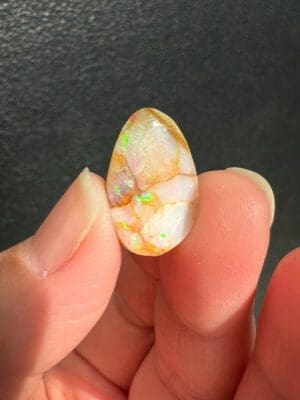
| Gemstone | Description |
|---|---|
| Garnet | Often deep red or purple, garnets are widely found across the northern parts of Idaho. |
| Opal | Idaho’s opals, especially from Spencer, are known for their brilliance and range of colors. |
| Jasper | A variety of chalcedony, jasper in Idaho often exhibits red, brown, or green hues with beautiful patterns. |
| Quartz | From transparent to milky, quartz can be found in many of Idaho’s mining areas. |
| Agate | Often translucent and banded, agate is a common find in many of Idaho’s riverbeds and mining areas. |
| Pyrite | Known as “Fool’s Gold” due to its metallic luster and yellow hue, pyrite is prevalent in Idaho. |
| Hematite | This iron ore, known for its metallic gray or black appearance, is common in some of Idaho’s regions. |
| Chalcedony | A microcrystalline form of silica, it can be found in various colors including blue, lavender, and white. |
| Obsidian | This volcanic glass can be found in black, brown, or green and is often used for tools and jewelry. |
| Cinnabar | A mercury sulfide mineral, cinnabar is known for its bright red color and is the primary ore of mercury. |
These tables encapsulate just a fraction of the vast mineral diversity present in Idaho. Whether you’re an expert or just getting started, Idaho offers gemstone experiences like few other places.
Top 10 Gem Mining Locations in Idaho
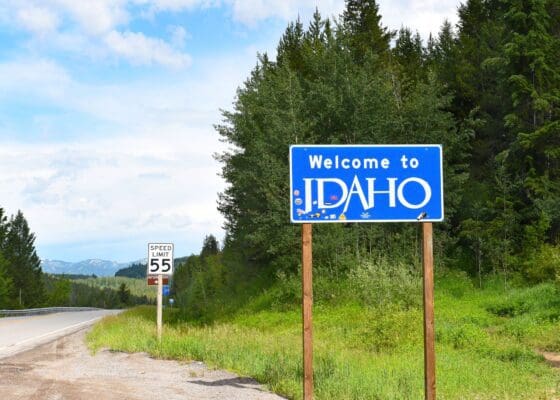
- Emerald Creek Garnet Area – Located in the Panhandle National Forests, it’s a favorite spot for garnet enthusiasts. Operating hours usually span from May to September. Small fees apply depending on the volume of material you process.
- Spencer Opal Mines – Situated near Spencer, it’s the primary location to mine opals in Idaho. Typically open from Memorial Day through Labor Day, there’s a fee per bucket, which varies depending on the type and size.
- Graves Mountain – Rich in quartz, rutile, and other minerals, Graves Mountain offers dig dates throughout the year. Fees vary based on the specific date and time.
- St. Joe River – Located near the town of Avery, it’s an excellent spot for finding star garnets, particularly along the riverbanks. Public access is free, but always respect private property.
- Rock Flat gold placers near New Meadows – Historically a gold mining site, it’s also known to contain garnets and other precious stones. Hours and access might vary; always check with local regulations.
- Walker Mine – Found in the Elmore County area, this old copper mine offers opportunities to find gemstones like garnet and epidote. It’s best to inquire locally for operating hours and fees.
- Blade Creek – Located in Owyhee County, Blade Creek is rich in jasper, particularly the sought-after Bruneau jasper. It’s a public area, so no fees apply, but mining etiquette should always be followed.
- Carey Garnet Mine – Situated near the town of Carey in Blaine County, it’s a prime spot for garnets. While there might be no official operating hours, it’s recommended to visit during daylight for safety reasons.
- Indian Bathtub opal mine near Spencer – Another treasure in the Spencer region, this mine yields opals in a variety of colors. Fees are typically charged by the bucket or bag.
- Daisy Creek – Located in Lemhi County, this creek is known for its rich deposits of gold and sapphires. While public access is open, it’s always best to check local regulations and any potential fees.
While these are some of the top gem mining sites in Idaho, there are countless more waiting to be explored. Always ensure to follow local guidelines, respect the environment, and prioritize safety when mining.
History of Gem Mining in Idaho
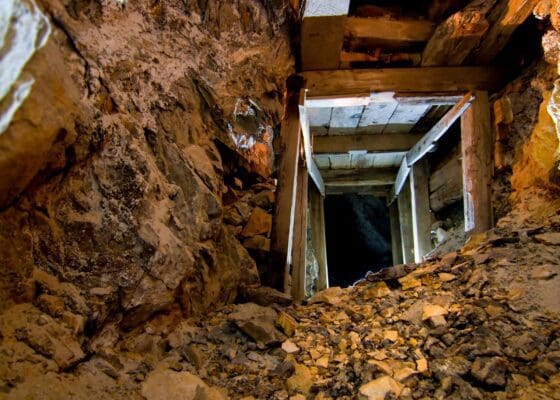
Gem mining in Idaho is steeped in a rich tapestry of exploration, discovery, and cultural significance. Long before the advent of commercial mining, Native Americans traversed the region’s vast landscapes, collecting an array of gemstones for ceremonial and decorative purposes. Their intimate knowledge of the land’s geology was an essential foundation for what would come next.
In the mid-19th century, the discovery of significant gold deposits in the state drew an influx of settlers and prospectors to Idaho’s borders. While the allure of gold was undeniable, these new arrivals soon realized that Idaho’s mineral wealth extended far beyond just gold. The state’s rugged terrains, combined with its unique geological positioning, fostered a variety of precious and semi-precious gemstones.
The mining boom of the late 19th and early 20th centuries solidified Idaho’s reputation as a veritable “Gem State.” As mines sprouted across the state, Idaho garnets, opals from Spencer, and the unique star garnets began to draw global attention. The commercial viability of these gems, combined with the aesthetic beauty they held, led to an increased demand in domestic and international markets.
The town of Spencer, for example, experienced rapid growth in the late 1800s due to its opal deposits. By the turn of the century, it became synonymous with high-quality opals, drawing enthusiasts, collectors, and jewelers from all corners of the world. Similarly, the region surrounding the Emerald Creek was renowned for producing garnets of unparalleled clarity and color.
As mining technologies evolved, the methods of extraction became more sophisticated. However, the essence of gem hunting, with its allure of discovery, remained unchanged. The fusion of tradition with technology is a testament to Idaho’s enduring legacy in the realm of gem mining.
Today, while large-scale commercial mining has declined, recreational mining has seen a surge in popularity. Tourists and locals alike are eager to partake in the timeless adventure of unearthing Idaho’s gemstones, continuing a tradition that has thrived for centuries.
Gem Mining Regulations in Idaho

Mining, even when done recreationally, is an activity that can have profound impacts on the environment and the socio-economic fabric of a region. Therefore, understanding the regulations governing gem mining in Idaho is not just a matter of legal compliance, but also a commitment to responsible and sustainable practices.
In Idaho, gem mining, like other forms of mineral extraction, is subject to both state and federal laws. However, the emphasis on Idaho’s gemstones, given their cultural and economic significance, has led to specific regulations tailored to protect both the gem resources and the ecosystems where they are found.
- Land Ownership and Permissions: Before embarking on a mining venture, it’s imperative to ascertain the ownership of the land. While Idaho boasts vast stretches of public lands, not all are open to mining. Private lands, tribal territories, and certain protected public lands require explicit permissions. When in doubt, always consult with the Bureau of Land Management or local county offices.
- Recreational vs. Commercial Mining: Recreational mining is generally permitted without specialized licenses on designated public lands. However, if you intend to sell the gemstones you find, or if you’re using machinery or explosives, you may transition into the realm of commercial mining, which requires specific permits.
- Environmental Protection: One of the core tenets of Idaho’s mining regulations is environmental stewardship. Miners are mandated to follow “Leave No Trace” principles. This means any pits or disturbances created during the mining process should be restored to their natural state.
- Streambed and River Mining: Special considerations apply to mining in aquatic ecosystems. Disturbing riverbeds can adversely affect aquatic life. Consequently, certain streams, especially those housing endangered species, might have restrictions or bans on mining activities.
- Fee Collection Areas: Some of the more popular gem mining sites in Idaho may require a fee. These fees contribute to the maintenance of the area, ensuring its viability and accessibility for future generations of miners.
- Safety Regulations: Safety is paramount. Certain areas, especially caves or underground mines, may have strict regulations regarding the equipment used, the number of people allowed simultaneously, or even the times of year when mining is permitted, all to ensure the safety of the miners.
- Reporting: On discovering a particularly large or significant gem deposit, there might be stipulations to report the find to state authorities. This isn’t to confiscate the find, but rather to document and potentially study the geological significance.
In essence, while Idaho offers a plethora of opportunities for gem enthusiasts, it’s crucial that the journey to discover these geological marvels is undertaken with an understanding and respect for the land, its history, and its future. Mining regulations serve as a roadmap to ensure that the allure of gem hunting is preserved for generations to come.
Necessary Tools and Equipment for Gem Mining in Idaho
Gem mining in Idaho, much like in other states, is an exciting venture that merges the thrill of the hunt with the beauty of nature. Whether you’re digging in open pits, sifting through riverbeds, or exploring cavernous depths, the right tools can make all the difference. They not only increase your chances of unearthing valuable gemstones but also ensure your safety throughout the process.
1. Screening and Classifying Tools: Reveal those hidden treasures!
Description: Many gemstones are found amidst loose soil or river sediments. A set of sieves or screens with different mesh sizes can help filter out larger debris, leaving behind potential gemstones. A gold pan, often used in panning for gold, is equally effective for gem hunting in riverbeds.

🛒 Explore Top Screening Sets on Amazon
2. Shovels and Trowels: Digging deep or just scratching the surface?
Description: Digging tools, ranging from full-sized shovels to handheld trowels, come in handy especially if you’re venturing into fields or lightly forested areas where gems might be found just below the surface.

🛒 Find Quality Shovels and Trowels on Amazon
3. Picks and Hammers: The backbone of any gem hunting endeavor.
Description: Unlike regular hammers, geology hammers are designed to break rocks, revealing what lies within. Paired with a chisel, they allow for precision breaking, which can be crucial when trying to extract a gem without damaging it.

🛒 Check Out Best Picks and Hammers on Amazon
4. Buckets: Your trusted companion for carrying treasures.
Description: As you find potential gemstones, you’ll need somewhere to store them. Buckets are great for larger finds or when screening large amounts of sediment. Smaller cloth or leather bags can be used to store individual gems.
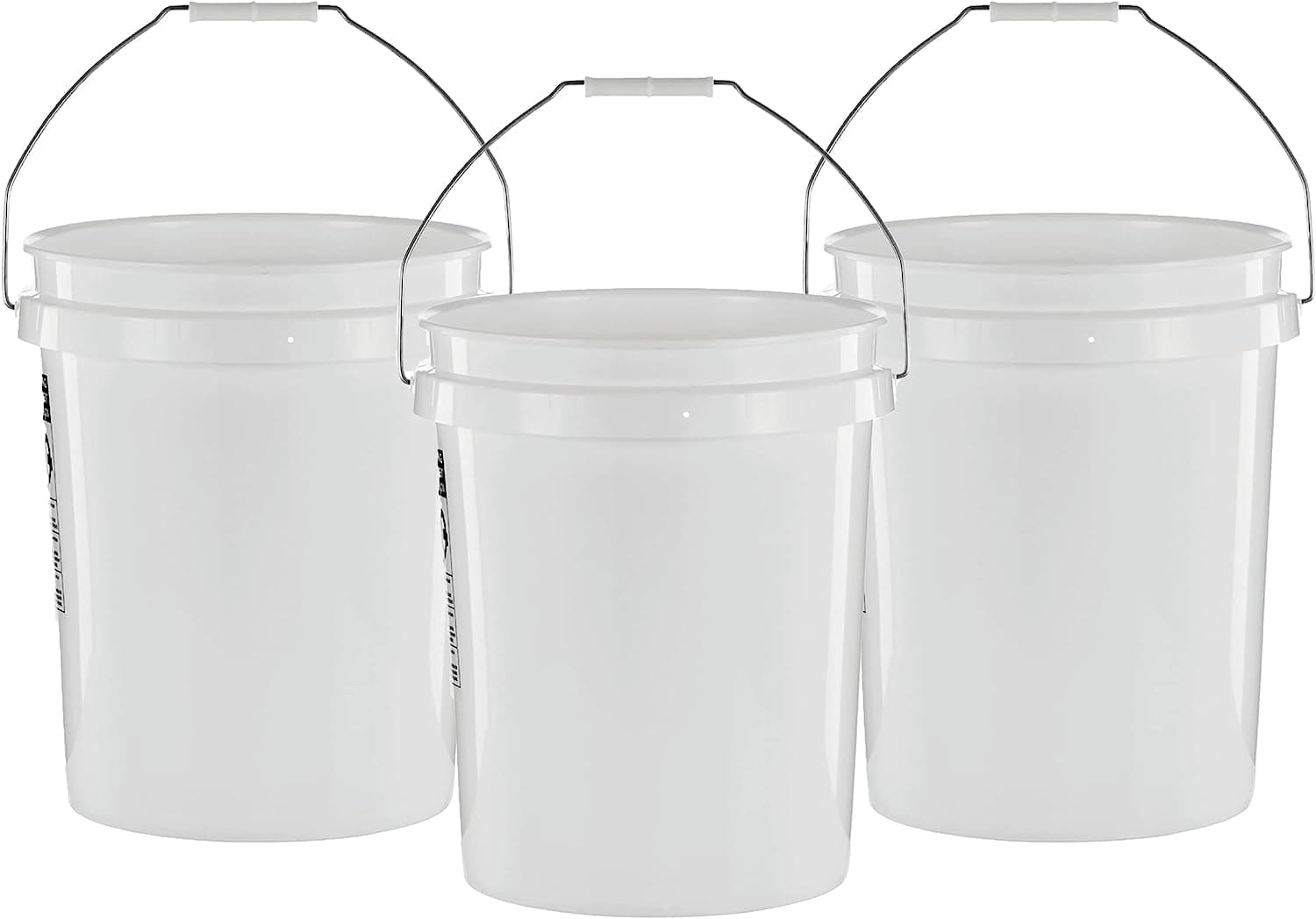
🛒 Shop for Reliable Buckets on Amazon
5. Magnifying Glass: Every detail counts!
Description: Some gems or minerals can be quite small or require closer examination to determine their value. A good magnifying glass or jeweler’s loupe provides this clarity.

🛒 Grab Your Magnifying Glass on Amazon
6. Guidebooks and Field Guides: Knowledge at your fingertips.
Description: Especially for beginners, a field guidebook to Idaho’s gemstones can be invaluable. These guidebooks offer images and descriptions of gems, helping you identify your finds on the spot.

🛒 Discover the Best Field Guides on Amazon
7. Containers and Bags: Organize, store, and flaunt your finds.
Description: As you gather gemstones, having durable bags or buckets ensures safe storage. Labeling them based on location or type of stone can be helpful for post-trip analysis.

🛒 Shop for Storage Solutions on Amazon
8. First Aid Kit: Better safe than sorry!
Description: Accidents, however minor, can happen. A basic first aid kit equipped with bandages, antiseptics, and other essentials can address minor injuries immediately.

🛒 Secure Your First Aid Kit on Amazon
Incorporating these tools and equipment into your gem hunting expeditions in Idaho not only enhances the experience but ensures that you’re well-prepared for various scenarios. Remember, the goal is not just to find gems, but to enjoy the journey while doing so safely.
Tips and Tricks for Successful Gem Mining in Idaho

Gem mining in Idaho is as much about strategy as it is about enthusiasm. With the state’s diverse topography and array of gems hidden beneath its surface, knowing how to optimize your mining expedition can be the key to a rewarding experience. Here are some insights to make the most out of your gem hunting venture:
- Research Before You Go: Familiarize yourself with the specific gems you’re aiming to find. By understanding their typical locations and the geological formations in which they reside, you’ll save time and increase your chances of a fruitful hunt.
- Start Early: Many mining sites, especially in the summer, can get crowded and hot as the day progresses. Starting early not only provides cooler temperatures but also fewer distractions, allowing a more peaceful and focused mining experience.
- Safety First: It’s essential always to prioritize safety. Steer clear of precarious ledges, be cautious around water sources, and always inform someone about your whereabouts and expected return time, especially if mining in a remote location.
- Stay Patient: Gem hunting is as much about patience as it is about luck. You might spend hours without a significant find and then suddenly stumble upon a gemstone worth all that effort.
- Hydration and Nutrition: The physical activity combined with Idaho’s varying altitudes can be taxing. Ensure you’re adequately hydrated and have enough snacks or meals to keep your energy levels up.
- Join a Group: Especially for beginners, joining a gem hunting group or guided tour can provide valuable insights. Experienced members can share their knowledge, and there’s an added layer of safety in numbers.
- Respect the Environment: Leave no trace. Any pits or disturbances you create should be restored to their natural state. Ensure you’re not disrupting local wildlife or plant life in your quest for gems.
- Learn the Land: Familiarize yourself with the topographical nuances of your chosen location. River bends, for example, are often great places to find gems due to the natural sediment deposits.
- Keep Records: Documenting where and what you find can be invaluable for future trips. Over time, you’ll build a personalized map of fruitful spots.
- Double-Check Your Finds: Sometimes, what might seem insignificant at first glance could turn out to be a valuable gemstone. Before discarding anything, ensure you’ve examined it thoroughly.
Gem mining in Idaho is a journey, blending the allure of discovery with the serenity of nature. With these tips in hand, you’re better equipped to navigate the terrains, appreciate the nuances, and maximize your chances of unearthing Idaho’s hidden treasures.
Handling Your Gemstone Finds
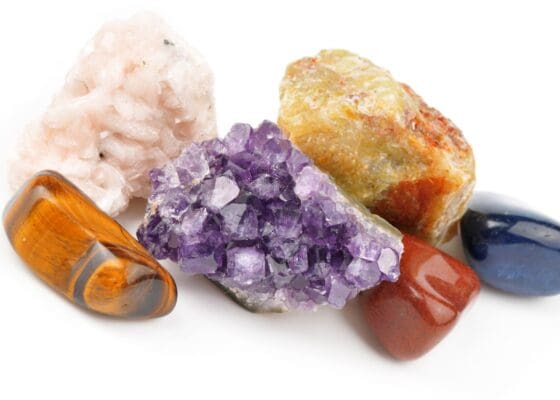
Unearthing a gemstone in the rugged terrains of Idaho can be exhilarating. However, the journey of a gem doesn’t end with its discovery. Proper handling, cleaning, and preservation are essential to showcasing its true beauty and value. Here’s a guide to treating your finds with the care they deserve:
- Gentle Cleaning: The first step after extraction is to remove any dirt or clay. Use a soft brush and water to gently clean the stone. Avoid using chemicals or abrasive materials, as these can damage or scratch many gemstones.
- Identification: Before any further processing, it’s essential to identify your gemstone. This not only gives you a sense of its value but also guides further treatment. Guidebooks, local gemology experts, or gemstone clubs can be invaluable resources.
- Storing Safely: Always store gemstones individually to prevent them from scratching each other. Soft, padded pouches or compartmentalized boxes work best. For especially valuable or delicate gems, consider using acid-free tissue paper as an added layer of protection.
- Seek Expertise: If you believe you’ve found a particularly valuable gemstone, consult a gemologist or experienced lapidarist. They can provide insights into its quality, potential value, and the best methods for cutting or polishing.
- Polishing and Cutting: Some gems might benefit from cutting or polishing to enhance their beauty. While enthusiasts can learn these skills, beginners might consider seeking professional services for optimal results.
- Displaying Your Finds: Display cases, shadow boxes, or even making jewelry are popular ways to showcase your gemstones. Ensure the environment is dry and free from direct sunlight to prevent any damage or color fading.
- Documentation: Maintain a logbook detailing where and when each gem was found, its characteristics, and any treatments it underwent. This not only provides a historical record but can be essential for valuation or resale purposes.
- Value and Insurance: For particularly valuable finds, consider getting them appraised and insured. This protects your investment and provides peace of mind.
- Continuous Learning: Gem handling and processing is a vast field. Continuously educate yourself by attending workshops, joining clubs, or reading up on the latest techniques and discoveries.
- Respect the Gem: Remember that each gemstone, no matter its market value, is a piece of Idaho’s rich geological tapestry. Treat it with the reverence it deserves.
In essence, the way you handle your gemstone finds determines how well their innate beauty and value are revealed. With careful consideration and informed decisions, you can ensure these treasures of the earth shine their brightest.
Famous Gemstone Finds in Idaho
Idaho’s diverse geology has long been the backdrop for some of the most spectacular gemstone finds in the United States. The tales of these discoveries, many passed down through generations, add a layer of mystique to the state’s already rich gem hunting legacy. Let’s delve into some of the most legendary finds that have cemented Idaho’s reputation as a gemstone paradise:
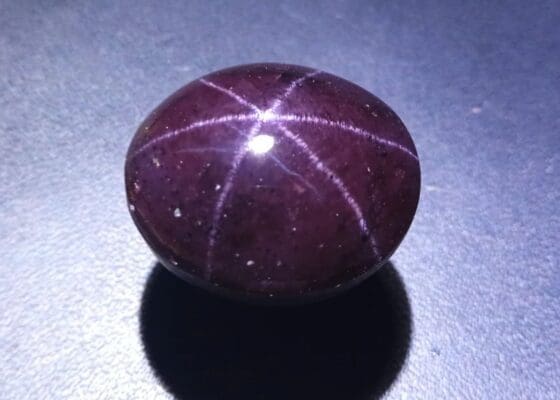
- The Star Garnet: Idaho is one of only two places in the world (the other being India) where star garnets are found. These rare gemstones exhibit a star-like pattern on their surface due to the presence of rutile needles within the gem. A particularly large and flawless star garnet was discovered in the early 20th century in the Emerald Creek area, drawing attention to Idaho’s gem potential.
- The “Bruneau” Jasper: Found exclusively in the Bruneau River Canyon, this type of jasper is renowned for its unique patterns that often resemble scenic landscapes. One exceptional find in the 1980s showcased a perfect depiction of a rolling hillside beneath a sunset, capturing the beauty of Idaho’s landscapes within a gemstone.
- The Idaho Diamond: In the late 1960s, an extraordinary clear quartz crystal was unearthed, so flawless that it was initially mistaken for a diamond. Though later identified as quartz, its sheer size and clarity have made it a legendary find among local gem enthusiasts.
- The Spencer Opal: Spencer, Idaho, has been a renowned opal mining area for decades. One of the most notable discoveries was a large, fiery opal found in the 1950s, exhibiting brilliant plays of color. This find reinvigorated interest in the Spencer mines and solidified their reputation.
- Lemhi Pass Aquamarines: Nestled within the Salmon-Challis National Forest, the Lemhi Pass area has been a hotspot for aquamarine finds. In the late 1990s, a particularly vibrant blue aquamarine crystal cluster was discovered, highlighting the area’s potential.
- Smoky Quartz of the Sawtooth Range: In the early 2000s, a hiker in the Sawtooth National Recreation Area stumbled upon a large smoky quartz point. Its nearly black hue, combined with its size, made it an exceptional find.
These legendary discoveries are more than just tales of fortune; they’re a testament to the geologic wonders hidden beneath Idaho’s surface. For every famous find, countless other stories remain untold, waiting for the next eager gem hunter to unearth Idaho’s hidden treasures.
Additional Gem Mining Opportunities
For those who’ve caught the gem hunting bug after their adventures in Idaho, there’s a wealth of opportunities waiting just beyond the state’s borders. The surrounding states, each with its unique geological tapestry, promise a plethora of gem mining experiences. Here’s a glimpse of what neighboring states offer:
- Montana Gem Mining: Often referred to as the “Treasure State,” Montana is renowned for its sapphires, especially from the Yogo Gulch. Additionally, agates, garnets, and gold can be sourced from its terrains.
- Wyoming Gem Mining: Wyoming, known for its vast landscapes, holds deposits of jade, opal, and the elusive red diamond. The state’s Sweetwater River is famous for its gold and agate finds.
- Utah Gem Mining: With its deserts and high plateaus, Utah is a hotspot for topaz, especially in the Topaz Mountain area. Bixbite, opals, and amethysts also beckon gem enthusiasts to this state.
- Nevada Gem Mining: Beyond its fame for gold and silver, Nevada is rich in turquoise, especially from the Royston and Lander Blue mines. Opals from the Virgin Valley are also highly sought after.
- Oregon Gem Mining: Oregon’s diverse geology yields sunstones, opals, and agates. The state’s public collection areas, like the Spectrum Sunstone Mine, offer fruitful opportunities for both novices and experts.
- Washington Gem Mining: The “Evergreen State” is not only green in its landscapes but also in its gems, with notable jade and garnet deposits. Additionally, petrified wood and agates are common finds along its beaches.
Each of these states carries forward the legacy of the American West’s rich mineral heritage, offering gem hunters a continuation of their quest, each landscape telling its unique tale of geological wonder.
Delve into the ultimate gem mining resource – check out our Gem Mining Near Me guide!
The Allure of Gem Quests and Home-Based Discoveries
The enchantment of gem hunting in Idaho lies not just in the vibrant and varied gems waiting to be discovered but also in the very journey — the quest through Idaho’s diverse landscapes, the thrill of unearthing a hidden treasure, and the stories and history attached to each find. However, not everyone can make the journey to the gem-rich terrains of the Gem State.
Enter the gem mining kit: an alternative that brings the adventure right to your doorstep. With these kits, enthusiasts can experience the excitement of discovery without leaving the comfort of their homes. Each kit contains a medley of rough gemstones embedded in dirt or sand, simulating a real-life mining experience. As you sift through, you never know what treasures you might unveil. It’s a perfect blend of education, entertainment, and the timeless allure of treasure hunting, ensuring the magic of gem discovery is accessible to all.

